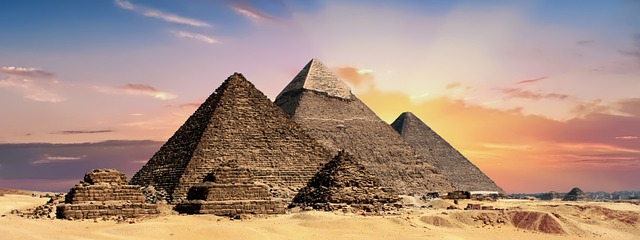
The Pyramids of Giza, standing majestically on the outskirts of Cairo, Egypt, are among the most iconic and enduring symbols of ancient civilization. These colossal structures have fascinated historians, archaeologists, and travelers for millennia. Built during Egypt’s Old Kingdom, they have withstood the test of time, continuing to intrigue with their grandeur and mysteries. This detailed guide explores the history, significance, and features of the Pyramids of Giza, offering practical tips for visitors.
A Historical Overview
The Pyramids of Giza were constructed during the Fourth Dynasty of the Old Kingdom of ancient Egypt, around 2580 to 2560 BCE. Commissioned by Pharaohs Khufu, Khafre, and Menkaure, these pyramids served as monumental tombs, reflecting the Egyptians’ complex beliefs about the afterlife and their remarkable engineering skills.
The Great Pyramid of Khufu
The largest and most renowned of the three pyramids is the Great Pyramid of Khufu, also known as Cheops. Originally standing at 146.6 meters (481 feet), it was the tallest man-made structure in the world for over 3,800 years. Built with approximately 2.3 million limestone blocks, the precision and scale of the Great Pyramid remain awe-inspiring.
Pyramid of Khafre
Khafre’s pyramid, the second largest at Giza, appears taller than Khufu’s due to its elevated location on the Giza Plateau. It retains some of its original smooth casing stones at the apex, offering a glimpse into how the pyramids might have originally appeared. Khafre’s complex also includes the Great Sphinx, a colossal limestone statue with the body of a lion and the head of a pharaoh.
Pyramid of Menkaure
The smallest of the three pyramids, the Pyramid of Menkaure, stands at 65 meters (213 feet). Despite its size, it boasts intricate mortuary temples and a distinctive construction, incorporating large granite blocks.
Architectural and Engineering Marvels
The Pyramids of Giza are not only tombs but also architectural masterpieces that demonstrate the ancient Egyptians’ advanced knowledge of mathematics, astronomy, and engineering.
Construction Techniques
The exact methods used to construct the pyramids remain a subject of debate among scholars. It is widely believed that skilled laborers, rather than slaves, used a combination of ramps, levers, and sheer manpower to transport and position the massive limestone blocks. Recent discoveries suggest that a sophisticated system of waterways and canals might have played a role in transporting materials.
Astronomical Alignments
The pyramids are precisely aligned with the cardinal points of the compass, and their layout is thought to reflect important astronomical and religious beliefs. The Great Pyramid’s sides are aligned with the four cardinal directions, and its internal passageways are oriented toward specific stars, indicating the Egyptians’ advanced understanding of astronomy.
The Great Sphinx
The Great Sphinx, an integral part of the Giza complex, adds to the site’s allure. Carved from a single limestone ridge, the Sphinx measures 73 meters (240 feet) in length and 20 meters (66 feet) in height. The enigmatic expression and missing nose have given rise to numerous legends and theories. The Sphinx is believed to represent Pharaoh Khafre, serving as a guardian for his pyramid complex.
Visiting the Pyramids of Giza
A visit to the Pyramids of Giza is a journey back in time, offering a profound glimpse into ancient Egyptian civilization. Here are some practical tips and highlights for making the most of your visit.
Getting There
The Pyramids of Giza are located about 13 kilometers (8 miles) southwest of Cairo. They can be reached by taxi, bus, or organized tours. The site is easily accessible from most parts of Cairo, and many hotels offer shuttle services.
Best Time to Visit
The best time to visit the Pyramids of Giza is during the cooler months from October to April. The weather is more pleasant, making it easier to explore the site. Early mornings or late afternoons are ideal to avoid the midday heat and large crowds.
Ticket Information
Tickets to the Pyramids of Giza can be purchased at the entrance. Different ticket options are available, including access to the pyramids’ interiors and the Solar Boat Museum. It’s advisable to check the latest ticket prices and opening hours before your visit.
Exploring the Site
- The Great Pyramid: Visitors can enter the Great Pyramid of Khufu, ascending narrow passageways to reach the King’s Chamber. The interior is relatively plain, but the experience of being inside one of the ancient wonders is unforgettable.
- The Solar Boat Museum: Located near the Great Pyramid, this museum houses a reconstructed solar barque, believed to have been used in the pharaoh’s journey to the afterlife.
- The Great Sphinx: While visitors cannot climb the Sphinx, viewing platforms offer excellent photo opportunities and a chance to appreciate its grandeur up close.
Guided Tours
Hiring a knowledgeable guide can greatly enhance your visit, providing historical context and fascinating insights into the pyramids’ construction, purpose, and significance. Many tours include transportation and can be tailored to specific interests.
The Mysteries and Legends
The Pyramids of Giza have inspired countless myths, legends, and theories. From speculations about their construction to theories about hidden chambers and secret messages, these mysteries add to the pyramids’ allure.
Hidden Chambers
The search for hidden chambers within the pyramids has intrigued archaeologists for centuries. Recent technological advancements, such as muon radiography, have revealed anomalies suggesting the presence of undiscovered spaces within the Great Pyramid.
The Curse of the Pharaohs
The so-called “Curse of the Pharaohs” is a popular legend suggesting that those who disturb the tombs will suffer bad luck or death. While these stories are largely fictional, they contribute to the mystique surrounding the pyramids.
Conclusion
The Pyramids of Giza are more than just monumental tombs; they are a testament to the ingenuity, ambition, and spirituality of ancient Egypt. Visiting this UNESCO World Heritage site offers a profound connection to one of the world’s greatest civilizations. From the towering Great Pyramid to the enigmatic Sphinx, the Pyramids of Giza continue to captivate and inspire, standing as eternal symbols of human achievement.